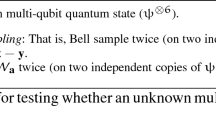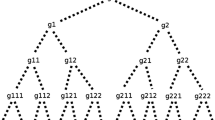Abstract
In this paper we prove that if \(\{a,b,c\}\) is a Diophantine triple with \(a<b<c\), then \(\{a+1,b,c\}\) cannot be a Diophantine triple. Moreover, we show that if \(\{a_1,b,c\}\) and \(\{a_2,b,c\}\) are Diophantine triples with \(a_1<a_2<b<c < 16b^3\), then \(\{a_1,a_2,b,c\}\) is a Diophantine quadruple. In view of these results, we conjecture that if \(\{a_1,b,c\}\) and \(\{a_2,b,c\}\) are Diophantine triples with \(a_1<a_2<b<c\), then \(\{a_1,a_2,b,c\}\) is a Diophantine quadruple.
Similar content being viewed by others
References
J. Arkin, V.E. Hoggatt, E.G. Strauss, On Euler’s solution of a problem of Diophantus. Fibonacci Q. 17, 333–339 (1979)
A. Baker, H. Davenport, The equations \(3x^2-2=y^2\) and \(8x^2-7=z^2\). Q. J. Math. Oxf. Ser. (2) 20, 129–137 (1969)
M.A. Bennett, On the number of solutions of simultaneous Pell equations. J. Reine Angew. Math. 498, 173–199 (1998)
Y. Bugeaud, A. Dujella, M. Mignotte, On the family of Diophantine triples \(\{k-1, k+1,16k^3-4k\}\). Glasg. Math. J. 49, 333–344 (2007)
M. Cipu, Y. Fujita, Bounds for Diophantine quintuples. Glas. Math. Ser. III(50), 25–34 (2015)
M. Cipu, Y. Fujita, M. Mignotte, Two-parameter families of uniquely extendable Diophantine triples. Sci. China Math. 61, 421–438 (2018)
M. Cipu, Y. Fujita, T. Miyazaki, On the number of extensions of a Diophantine triple. Int. J. Number Theory 14, 899–917 (2018)
A. Dujella, An absolute bound for the size of Diophantine \(m\)-tuples. J. Number Theory 89, 126–150 (2001)
A. Dujella, There are only finitely many Diophantine quintuples. J. Reine Angew. Math. 566, 183–224 (2004)
A. Dujella, A. Pethő, A generalization of a theorem of Baker and Davenport. Q. J. Math. Oxf. Ser. (2) 49, 291–306 (1998)
A. Filipin, Y. Fujita, The number of Diophantine quintuples II. Publ. Math. Debr. 82, 293–308 (2013)
A. Filipin, Y. Fujita, A. Togbé, The extendibility of Diophantine pairs II: examples. J. Number Theory 145, 604–631 (2014)
Y. Fujita, The extensibility of Diophantine pairs \(\{k-1, k+1\}\). J. Number Theory 128, 322–353 (2009)
B. He, K. Pu, R. Shen, A. Togbé, A note on the regularity of the Diophantine pair \(\{k,4k\pm 4\}\). J. Théor. Nombres Bordeaux 30, 879–892 (2018)
B. He, A. Togbé, On a family of Diophantine triples \(\{k, A^2k+2A, (A+1)^2k+2(A+1)\}\) with two parameters. Acta Math. Hung. 124, 99–113 (2009)
B. He, A. Togbé, On a family of Diophantine triples \(\{k, A^2k+2A, (A+1)^2k+2(A+1)\}\) with two parameters II. Period. Math. Hung. 64, 1–10 (2012)
B. He, A. Togbé, V. Ziegler, There is no Diophantine quintuple. Trans. Am. Math. Soc. 371, 6665–6709 (2019)
M. Laurent, M. Mignotte, Yu. Nesterenko, Formes linéaires en deux logarithmes et déterminants d’interpolation. J. Number Theory 55, 285–321 (1995)
T. Nagell, Introduction to Number Theory (Wiley, Almqvist, New York, Stockholm, 1951)
J.H. Rickert, Simultaneous rational approximations and related Diophantine equations. Proc. Camb. Philos. Soc. 113, 461–472 (1993)
Acknowledgements
The authors thank the referee for useful comments.
Author information
Authors and Affiliations
Corresponding author
Additional information
Publisher's Note
Springer Nature remains neutral with regard to jurisdictional claims in published maps and institutional affiliations.
Andrej Dujella acknowledges support from the QuantiXLie Center of Excellence, a project cofinanced by the Croatian Government and European Union through the European Regional Development Fund—the Competitiveness and Cohesion Operational Programme (Grant KK.01.1.1.01.0004). Andrej Dujella was supported also by the Croatian Science Foundation under the project no. IP-2018-01-1313. Yasutsugu Fujita was supported by JSPS KAKENHI Grant Number 16K05079.
Rights and permissions
About this article
Cite this article
Cipu, M., Dujella, A. & Fujita, Y. Diophantine triples with largest two elements in common. Period Math Hung 82, 56–68 (2021). https://doi.org/10.1007/s10998-020-00331-4
Published:
Issue Date:
DOI: https://doi.org/10.1007/s10998-020-00331-4




